Acadia National Park is faced with a series of questions relating
to the issue of conservation of biological diversity. These questions range
from "What birds nest in park estuaries", and "What role do park estuaries
play as staging habitat for migratory birds?" to "How have beaver
populations responded to forest succession?" and "What are cost-effective
techniques to control highly invasive non-native plants at the park,
including Japanese barberry (Berberis thunbergii), alder buckthorn
(Rhamnus frangula), and oriental bittersweet (Celastrus orbiculata)?"
These issues and more are expected to be addressed by researchers in association
with the park, with the use of the USGS-NPS vegetation mapping program data.
One initial application will be the modeling of bird species potentially
inhabiting an estuary, based on the vegetation types that grow there. This will
contribute to research on the effects of nearby development. The vegetation
data is expected to be used to determine the best places for bird surveys.
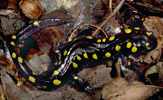 Other research at Acadia National Park includes a study of how
amphibian populations are effected by natural
changes (e.g., beaver dams and ecological succession) and anthropogenic changes
(road building, path construction, and beaver and fire management) in wetland
ecosystems. Field work will likely focus on patterns of amphibian
species distribution and abundance in relation to wetland vegetation and other
parameters. The USGS-NPS vegetation mapping data will be very useful in the
identification and location of the wetland ecosystems to be studied.
Other research at Acadia National Park includes a study of how
amphibian populations are effected by natural
changes (e.g., beaver dams and ecological succession) and anthropogenic changes
(road building, path construction, and beaver and fire management) in wetland
ecosystems. Field work will likely focus on patterns of amphibian
species distribution and abundance in relation to wetland vegetation and other
parameters. The USGS-NPS vegetation mapping data will be very useful in the
identification and location of the wetland ecosystems to be studied.
 The topography and location of Acadia National Park combine to
create a situation where the southern coastal deciduous forest meets
the northern coniferous forest. Many plants reach the edge of their range
within Acadia National Park. The northern limits of distribution of Bear Oak
(Quercus ilicifolia) and Pitch Pine (Pinus rigida) and the
southern limits of Jack Pine (Pinus banksiana) are found within the
Park. Seaside Mertensia (Mertensia maritima)is found within the Park;
elsewhere it grows only in a much more arctic environment. The USGS-NPS
vegetation mapping program data provides baseline data for studies of range
changes that may occur as a result of climate change.
The topography and location of Acadia National Park combine to
create a situation where the southern coastal deciduous forest meets
the northern coniferous forest. Many plants reach the edge of their range
within Acadia National Park. The northern limits of distribution of Bear Oak
(Quercus ilicifolia) and Pitch Pine (Pinus rigida) and the
southern limits of Jack Pine (Pinus banksiana) are found within the
Park. Seaside Mertensia (Mertensia maritima)is found within the Park;
elsewhere it grows only in a much more arctic environment. The USGS-NPS
vegetation mapping program data provides baseline data for studies of range
changes that may occur as a result of climate change.
 A diverse team of researchers from NPS, USGS, and the
University of Maine is studying regional patterns and responses of
nitrogen and mercury biogeochemistry at Acadia National Park.
To further NPS understanding of the effects of atmospheric deposition and
climate change on forested watersheds and surface waters, a long-term
study is planned to determine levels of mercury inputs to landscapes,
A diverse team of researchers from NPS, USGS, and the
University of Maine is studying regional patterns and responses of
nitrogen and mercury biogeochemistry at Acadia National Park.
To further NPS understanding of the effects of atmospheric deposition and
climate change on forested watersheds and surface waters, a long-term
study is planned to determine levels of mercury inputs to landscapes,
 identify locations and processes of mercury deposition, resolve the
status of nitrogen retention in forests, and estimate nitrogen-loading
to selected park estuaries. The USGS-NPS vegetation mapping data will be
used to identify burned and unburned forests where streams will be
gauged to track nitrogen and mercury deposition into and out of these
watersheds.
identify locations and processes of mercury deposition, resolve the
status of nitrogen retention in forests, and estimate nitrogen-loading
to selected park estuaries. The USGS-NPS vegetation mapping data will be
used to identify burned and unburned forests where streams will be
gauged to track nitrogen and mercury deposition into and out of these
watersheds.
Several vegetation related studies are under way at Acadia National Park
that will use the USGS-NPS vegetation mapping data. Objectives of these studies
include determination of the threat to Park ecosystems by invasive non-native
plants, the development of a rare plant monitoring program, and the current
and future distributions of pitch and Jack pine (Pinus rigida, Pinus banksiana)
in Maine.

 Assateague Island National Seashore is host to an on-going research
project on Yellow-rumped warblers (Dendroica coronata). These birds
winter in the park, at which time one of the staples of their diet is wax myrtle
(Myrica cerifera). Using the vegetation mapping data to select
vegetation types containing wax myrtle allows for a more robust research
sampling design.
Assateague Island National Seashore is host to an on-going research
project on Yellow-rumped warblers (Dendroica coronata). These birds
winter in the park, at which time one of the staples of their diet is wax myrtle
(Myrica cerifera). Using the vegetation mapping data to select
vegetation types containing wax myrtle allows for a more robust research
sampling design.
 Theodore Roosevelt National Park's Vegetation Map is contributing to
advanced remote sensing research for mapping invasive
leafy spurge (Euphorbia esula) in and adjacent to the park. A
team of scientists from the NPS, USGS, and the University of California, Davis
have been analyzing AVIRIS data collected over the park to examine the
feasibility of detecting and mapping leafy spurge via imaging spectroscopy.
The recently completed USGS-NPS Vegetation map at Theodore Roosevelt National
Park has proven to be a valuable aid in this research.
Theodore Roosevelt National Park's Vegetation Map is contributing to
advanced remote sensing research for mapping invasive
leafy spurge (Euphorbia esula) in and adjacent to the park. A
team of scientists from the NPS, USGS, and the University of California, Davis
have been analyzing AVIRIS data collected over the park to examine the
feasibility of detecting and mapping leafy spurge via imaging spectroscopy.
The recently completed USGS-NPS Vegetation map at Theodore Roosevelt National
Park has proven to be a valuable aid in this research.
 Forty-five miles of rustic
carriage roads
weave through Acadia National Park, the gift of
philanthropist John D. Rockefeller, Jr., and family. Rockefeller
desired to travel on motor-free byways via horse and carriage. His
construction efforts, from 1913 through 1940, resulted in roads with
sweeping vistas and close-up views of the landscape. The Park
is rehabilitating some of the vistas from the carriage
roads. The USGS-NPS vegetation mapping data will be especially
useful in this effort. Vegetation height and density classes
are expected to be integrated into the design to recreate the
scenes that Rockefeller wrote about.
Forty-five miles of rustic
carriage roads
weave through Acadia National Park, the gift of
philanthropist John D. Rockefeller, Jr., and family. Rockefeller
desired to travel on motor-free byways via horse and carriage. His
construction efforts, from 1913 through 1940, resulted in roads with
sweeping vistas and close-up views of the landscape. The Park
is rehabilitating some of the vistas from the carriage
roads. The USGS-NPS vegetation mapping data will be especially
useful in this effort. Vegetation height and density classes
are expected to be integrated into the design to recreate the
scenes that Rockefeller wrote about.

 At Acadia National Park a middle school teacher has volunteered to
create a lesson plan on vegetation mapping using a small area of the Park
as the focus for this lesson. Duplicate aerial photographs have been
acquired, and students will produce a vegetation map which they will
compare with the vegetation mapping program products.
At Acadia National Park a middle school teacher has volunteered to
create a lesson plan on vegetation mapping using a small area of the Park
as the focus for this lesson. Duplicate aerial photographs have been
acquired, and students will produce a vegetation map which they will
compare with the vegetation mapping program products.
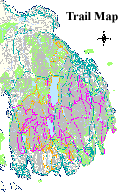 Historic trail system maintenance and planning at
Acadia National Park will be augmented using the
program data. Park staff will overlay the existing and
historic trail system on the vegetation map to analyze the
percentage of trails in the various vegetation types. This
information will be included in the decision making process for
determining the closure of existing trails and/or reopening of former
trail sections. This study would be very difficult to
accomplish without the USGS-NPS vegetation mapping data. In order
to approximate this analysis, Park staff would have to hike
the entire trail system and make extensive written observations.
Historic trail system maintenance and planning at
Acadia National Park will be augmented using the
program data. Park staff will overlay the existing and
historic trail system on the vegetation map to analyze the
percentage of trails in the various vegetation types. This
information will be included in the decision making process for
determining the closure of existing trails and/or reopening of former
trail sections. This study would be very difficult to
accomplish without the USGS-NPS vegetation mapping data. In order
to approximate this analysis, Park staff would have to hike
the entire trail system and make extensive written observations.

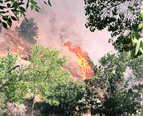 Fire management at Zion National Park includes both prescribed
and wild fire management. Fires can be prescribed for several reasons
including fuel reduction for human safety and for encouraging ecological
processes. The USGS-NPS vegetation mapping data will be included in the
fire management models with the goals of: optimizing the use of funds and
staff, using prescribed fire in areas with the greatest need, and doing
the best possible job of predicting wild and prescribed fire behavior.
Fire management at Zion National Park includes both prescribed
and wild fire management. Fires can be prescribed for several reasons
including fuel reduction for human safety and for encouraging ecological
processes. The USGS-NPS vegetation mapping data will be included in the
fire management models with the goals of: optimizing the use of funds and
staff, using prescribed fire in areas with the greatest need, and doing
the best possible job of predicting wild and prescribed fire behavior.

 Other research at Acadia National Park includes a study of how
amphibian populations are effected by natural
changes (e.g., beaver dams and ecological succession) and anthropogenic changes
(road building, path construction, and beaver and fire management) in wetland
ecosystems. Field work will likely focus on patterns of amphibian
species distribution and abundance in relation to wetland vegetation and other
parameters. The USGS-NPS vegetation mapping data will be very useful in the
identification and location of the wetland ecosystems to be studied.
Other research at Acadia National Park includes a study of how
amphibian populations are effected by natural
changes (e.g., beaver dams and ecological succession) and anthropogenic changes
(road building, path construction, and beaver and fire management) in wetland
ecosystems. Field work will likely focus on patterns of amphibian
species distribution and abundance in relation to wetland vegetation and other
parameters. The USGS-NPS vegetation mapping data will be very useful in the
identification and location of the wetland ecosystems to be studied.
 The topography and location of Acadia National Park combine to
create a situation where the southern coastal deciduous forest meets
the northern coniferous forest. Many plants reach the edge of their range
within Acadia National Park. The northern limits of distribution of Bear Oak
(Quercus ilicifolia) and Pitch Pine (Pinus rigida) and the
southern limits of Jack Pine (Pinus banksiana) are found within the
Park. Seaside Mertensia (Mertensia maritima)is found within the Park;
elsewhere it grows only in a much more arctic environment. The USGS-NPS
vegetation mapping program data provides baseline data for studies of range
changes that may occur as a result of climate change.
The topography and location of Acadia National Park combine to
create a situation where the southern coastal deciduous forest meets
the northern coniferous forest. Many plants reach the edge of their range
within Acadia National Park. The northern limits of distribution of Bear Oak
(Quercus ilicifolia) and Pitch Pine (Pinus rigida) and the
southern limits of Jack Pine (Pinus banksiana) are found within the
Park. Seaside Mertensia (Mertensia maritima)is found within the Park;
elsewhere it grows only in a much more arctic environment. The USGS-NPS
vegetation mapping program data provides baseline data for studies of range
changes that may occur as a result of climate change.
 A diverse team of researchers from NPS, USGS, and the
University of Maine is studying regional patterns and responses of
nitrogen and mercury biogeochemistry at Acadia National Park.
To further NPS understanding of the effects of atmospheric deposition and
climate change on forested watersheds and surface waters, a long-term
study is planned to determine levels of mercury inputs to landscapes,
A diverse team of researchers from NPS, USGS, and the
University of Maine is studying regional patterns and responses of
nitrogen and mercury biogeochemistry at Acadia National Park.
To further NPS understanding of the effects of atmospheric deposition and
climate change on forested watersheds and surface waters, a long-term
study is planned to determine levels of mercury inputs to landscapes,
 identify locations and processes of mercury deposition, resolve the
status of nitrogen retention in forests, and estimate nitrogen-loading
to selected park estuaries. The USGS-NPS vegetation mapping data will be
used to identify burned and unburned forests where streams will be
gauged to track nitrogen and mercury deposition into and out of these
watersheds.
identify locations and processes of mercury deposition, resolve the
status of nitrogen retention in forests, and estimate nitrogen-loading
to selected park estuaries. The USGS-NPS vegetation mapping data will be
used to identify burned and unburned forests where streams will be
gauged to track nitrogen and mercury deposition into and out of these
watersheds.

 Assateague Island National Seashore is host to an on-going research
project on Yellow-rumped warblers (Dendroica coronata). These birds
winter in the park, at which time one of the staples of their diet is wax myrtle
(Myrica cerifera). Using the vegetation mapping data to select
vegetation types containing wax myrtle allows for a more robust research
sampling design.
Assateague Island National Seashore is host to an on-going research
project on Yellow-rumped warblers (Dendroica coronata). These birds
winter in the park, at which time one of the staples of their diet is wax myrtle
(Myrica cerifera). Using the vegetation mapping data to select
vegetation types containing wax myrtle allows for a more robust research
sampling design.
 Theodore Roosevelt National Park's Vegetation Map is contributing to
Theodore Roosevelt National Park's Vegetation Map is contributing to
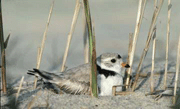 Assateague Island National Seashore is using the USGS-NPS vegetation
classification system in their potential habitat monitoring research. The
north end of Assateague
Island has significantly eroded due to the stabilization of an inlet and the
subsequent sand starvation of the northern end of the island. In order to avoid
a possible break-up of the island,
Assateague Island National Seashore is using the USGS-NPS vegetation
classification system in their potential habitat monitoring research. The
north end of Assateague
Island has significantly eroded due to the stabilization of an inlet and the
subsequent sand starvation of the northern end of the island. In order to avoid
a possible break-up of the island,
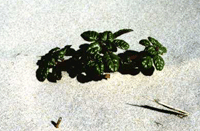 there is a proposal to add sand to the
effected area at the northern tip of the island. However, this might change the
amount of potential habitat available for two federally listed species found in
the area, piping plover (Charadrius melodus) and seabeach amaranth
(Amaranthus pumilus). By using the USGS-NPS vegetation
classification system within field transect efforts, Assateague Island
National Seashore is able to monitor the amount of potential habitat available
now and into the future. If this proposed sand deposition occurs, the park
will have sufficient information to assess the effects on the availability of
habitat for these endangered species.
there is a proposal to add sand to the
effected area at the northern tip of the island. However, this might change the
amount of potential habitat available for two federally listed species found in
the area, piping plover (Charadrius melodus) and seabeach amaranth
(Amaranthus pumilus). By using the USGS-NPS vegetation
classification system within field transect efforts, Assateague Island
National Seashore is able to monitor the amount of potential habitat available
now and into the future. If this proposed sand deposition occurs, the park
will have sufficient information to assess the effects on the availability of
habitat for these endangered species.


 Also at Voyageurs National Park, the vegetation types are being
used in the process of establishing forest breeding bird survey point
locations. Preferred vegetation types are identified, then points are
located in the GIS using the vegetation map and appropriate buffers are
applied. These points are displayed over digital ortho quads and/or
digital raster graphics. The points are navigated to using these maps
in association with landmarks and GPS units, and if necessary, the point
locations may then be modified.
Also at Voyageurs National Park, the vegetation types are being
used in the process of establishing forest breeding bird survey point
locations. Preferred vegetation types are identified, then points are
located in the GIS using the vegetation map and appropriate buffers are
applied. These points are displayed over digital ortho quads and/or
digital raster graphics. The points are navigated to using these maps
in association with landmarks and GPS units, and if necessary, the point
locations may then be modified.
 The USGS-NPS vegetation mapping program commonly collects height, density,
and pattern information about the vegetation. Zion National Park is
making use of the pattern data to incorporate a "patchiness" factor into
their habitat modeling efforts. The level of patchiness can have a large
impact on habitat preferences. Some species prefer vegetation patterns
which are more patchy, while other species prefer more homogeneous
vegetation cover. The Park is expecting to use the vegetation mapping
data for modeling habitat of a variety of species, including desert bighorn sheep
(Ovis canadensis nelsoni), mexican spotted owl (Strix occidentalis lucida),
peregrine falcon (Falco peregrines), southwest willow flycatcher
(Empidonax traillii extimus), northern goshawk (Accipiter gentilis),
virgin river spinedace (Lepidomeda mollispinus mollispinus), and
desert tortoise (Gopherus agassizii).
The USGS-NPS vegetation mapping program commonly collects height, density,
and pattern information about the vegetation. Zion National Park is
making use of the pattern data to incorporate a "patchiness" factor into
their habitat modeling efforts. The level of patchiness can have a large
impact on habitat preferences. Some species prefer vegetation patterns
which are more patchy, while other species prefer more homogeneous
vegetation cover. The Park is expecting to use the vegetation mapping
data for modeling habitat of a variety of species, including desert bighorn sheep
(Ovis canadensis nelsoni), mexican spotted owl (Strix occidentalis lucida),
peregrine falcon (Falco peregrines), southwest willow flycatcher
(Empidonax traillii extimus), northern goshawk (Accipiter gentilis),
virgin river spinedace (Lepidomeda mollispinus mollispinus), and
desert tortoise (Gopherus agassizii).
